With water filtration becoming more widely available at cheaper price points, many backpackers and survivalists are considering switching from chemical water treatment to filtration. But does filtration do the same thing?
Filtering water can improve the quality by removing suspended solids and many microorganisms (depending on filter pore size), but it doesn’t necessarily render water completely safe. Brackish water, or water contaminated with heavy metals, organic chemicals, or radioisotopes will need further treatment.
It takes a very small pore size to filter out all the microbes in water, and filters won’t do anything for dissolved contaminants. Make sure you know when to boil and disinfect in addition to filtration or when to distill instead!
Table of Contents
“But I Already Know Water Filtration!”
I take it for granted that you understand the importance of water to our lives. Water is absolutely critical to all functions of our body, and severe permanent damage can set in very quickly without it. Many quote the “Rule of 3” as saying people can survive, on average, up to about 3 days without water, but this varies wildly.
There are reports that a man survived locked in an Austrian jail cell, licking condensation off the walls, for eighteen days, but in a hot and arid climate, permanent damage can begin in hours.
However, drinking any old water you happen on in the woods isn’t a great idea. Most water sources, even those that look and smell great, are rich with microorganisms that can rapidly trigger vomiting, diarrhea, and possible nervous system collapse. No matter where you adventure, and even if you’re not an outdoorsy sort of person, knowledge of what to do with found water is so critical it should be taught to children.
It has been my experience that the internet can teach us a great many things about the world around us, including how to survive in less-than-ideal situations. Information on building fires and which knife steel is superior abounds, but one topic that wants for more coverage, in more detail, is the procurement of drinkable water.
Many blogs and survival manuals present a few methods for treating water in the outdoors, but the details are usually hazy, the merits discussed are often superficial, and the limits of each technology are often blatantly omitted.
This has resulted in a great many people in the survival community becoming unconsciously incompetent, a condition far more dangerous than knowing nothing about water treatment in the first place.
Let’s fix that.
What are we up against?

In order to make water safe to drink, we need to first understand what dangers the raw water source holds. Whether treating water in the backwoods or in a modern industrial drinking water treatment facility, the steps needed to clean and purify water depend on the contaminants in the source.
The United States Environmental Protection Agency (EPA) is the regulatory that defines the limits for municipal and commercial water treatment. These limits are often expressed in terms of milligrams per liter of water, levels far below what we can hope to achieve with improvised treatment methods, but they can help guide us in understanding what kinds of dangerous contaminants occur. To put it plainly, we will not be able to make water totally safe, only make it less unsafe.
The EPA has two sets of drinking water standards, primary and secondary. Primary drinking water standards are mandatory, for the protection of health and safety. Secondary standards are recommendations to help control odor, taste, and prevent undue wear on pumps and other machines.
Water that meets all primary standards is “safe to drink”, per the EPA, even if it does not comply with all secondary standards. This water could taste, look, and smell terrible, but still be safe. On the other hand, water that looks and tastes wonderful could be very, very dangerous.
However, our senses can still be helpful, as many biological contaminants do make water look cloudy and smell awful. In general, clear, fast-moving water will be of better quality than smelly stagnant water, but it should still undergo at least some treatment.
The primary drinking water standard contaminants are divided up into six categories: microorganisms, disinfectants, disinfection byproducts, inorganic chemicals, organic chemicals, and radionuclides. Many of these are undetectable without special equipment, even at dangerous concentrations.
What can Filters Do?
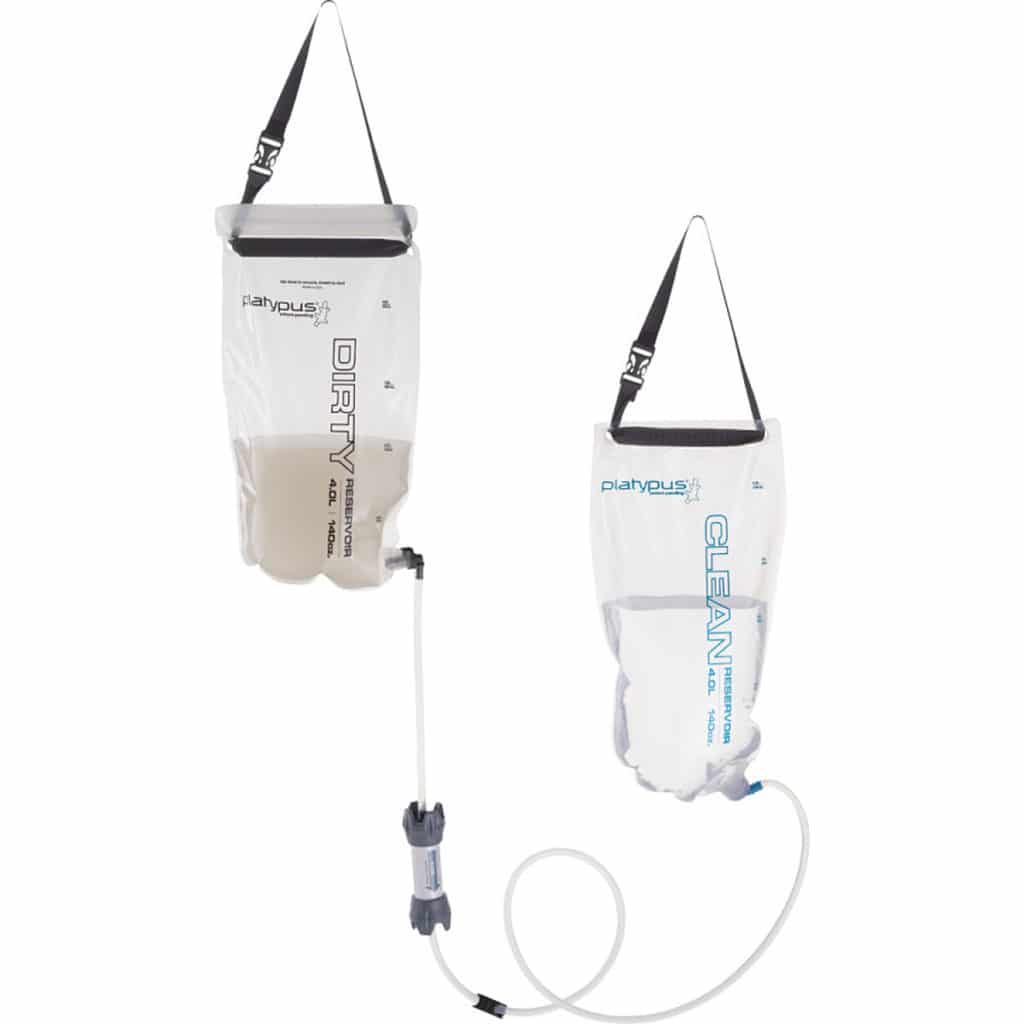
Filtration and settling target those contaminants that can be physically removed, because they are suspended in the water, rather than dissolved.
Take a warm glass of water and mix in a little salt. Stir it up, and it dissolves. You can’t filter that out, or wait for it to settle. But if you add enough salt, you saturate the water, and no more salt will dissolve, unless you heat the water up. To get the salt back, you’d have to resort to other means.
Now take a bottle of water and mix in some dirt. Shake that up, and it’ll go cloudy, but if you wait long enough, most of the dirt will settle back to the bottom. The dirt was suspended, rather than dissolved.
The finer the suspended particles, the longer they take to settle.
Some suspended particles won’t ever settle out on their own. They’re still physically separable, but they have enough electrostatic charge that they repel each other and can’t settle out.
Conventional Drinking Water Treatment
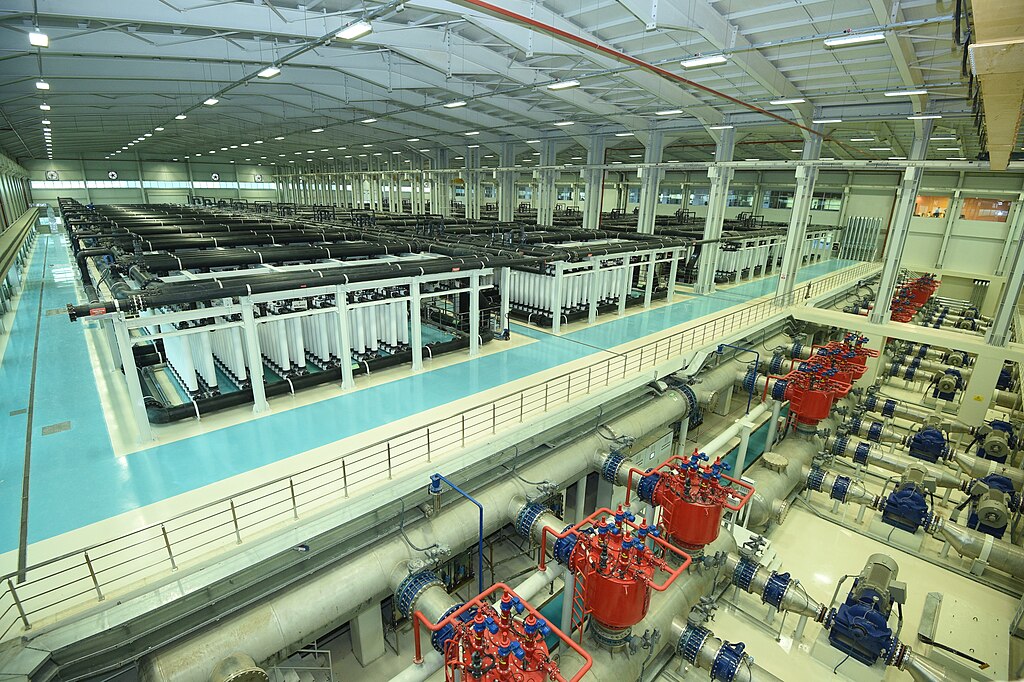
To overcome this, conventional water treatment plants introduce “coagulants”, substances like alum powder. Coagulants are oppositely charged, so they attract the existing particles to form clumps that settle out much faster than the individual particles.
Conventional water treatment plants mix in coagulants and other chemicals for treatment, then flow the water nice and slow through settling tanks to let the big stuff sink to the bottom before it hits the filters.
Filter beds, usually made up of anthracite coal pieces about 1 mm in diameter, sand at about 0.5 mm, and garnet sand at about 0.3 mm, act as giant strainers to remove the rest of the solids. The water then heads on to disinfection.
Microbes are the major target of this stage of treatment, with sizes of the typical bad actors ranging down to about 3 microns, the size of cryptosporidium spores. There’s a whole host of nasty microbes that need to be dealt with, but as cryptosporidium is the smallest, that’s the usual target.
Note that I mentioned the finest sand in conventional water filtration plant filters is about 0.3 mm in diameter, which is 300 microns.
How does that sand filter out particles 100 times smaller? It all comes back to the coagulation, which also serves to coagulate microbes into larger clumps.
Even after all the fancy coagulation and filtration, they disinfect. In the US, we disinfect with chlorine. In the EU, they usually opt for UV disinfection.
Backpacking Filters
Backpackers don’t usually coagulate or settle their water, so their filters need to be much finer. The Life Straw my wife got me for Christmas claims to filter out particles down to 0.3 microns, but the “pore size” or “mesh size” varies from filter to filter. Some of the cheaper or older ones don’t get down fine enough to catch everything, but depending on the local microbes, they may be good enough.
The penalty to pay for such fine pores is excessive back washing. Just like the strainer basket in a sink gets filled up with junk, filters will slowly lose flow rate / take more pressure to move water through over time.
The stuff you’re filtering out accumulates in and on the filter, and needs to get flushed out. Oftentimes this is done by flushing clean water back through the filter or manually cleaning the surface.
Neglect to do this with a backpacking filter, and not only will you work way harder than you need to, but you might create enough pressure to break the filter.
What if I don’t have a filter?
A nice MSR MiniWorks (my favorite water filter, always on hand when backpacking) will sure make your life easier.
But if you end up lost without a commercial water filter, there are many ways you can try to make do.
Settling / Coagulation
If you happen to be hiking with your pickling kit, break out the alum powder now. Mix that in to murky water and wait. Most of the sediment will drop out rapidly, and microbes will coagulate up for easy filtration. However, most of us don’t hike with alum. I’m in the process of investigating rumors of various natural plant-based coagulants to stand in for alum. More to come on this soon!
Many of the larger contaminants in water will simply drop out by themselves. Flowing water stays too churned up, but left still, many large particles settle out.
If you dig a hole in a sandy riverbank and let it fill up with water, that water will be very cloudy initially. Leave it sit for a few hours, and most of the dirt will settle out. The clarified water in the hole is cleaner than the river water, unless the riverbank happens to be a Superfund site.
Makeshift Filter
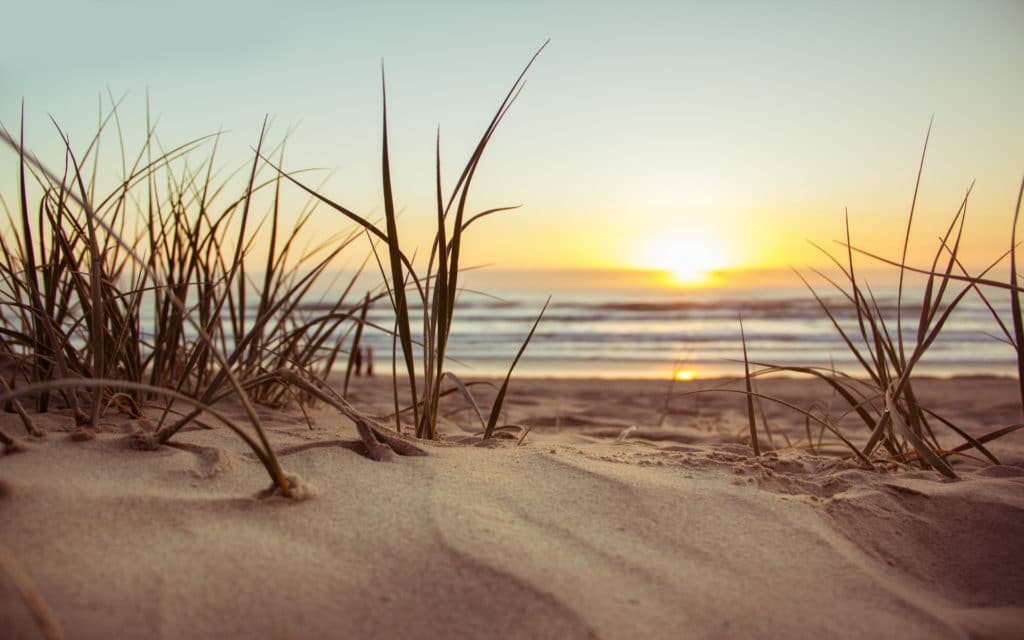
The hole dug next to a river is actually a means of filtration, as well as settling. Düsseldorf has been using Riverbank Filtration to provide clean water for over a hundred years, though they still disinfect it. The Bible even refers to this principle.
When riverbanks are in short supply, you can build your own. Come up with some sort of tube. It can be a soda bottle, bamboo, wood, or whatever else. Stop up one end with several layers of straw or grass to hold the sand in, then load it up with sand, gravel, or any other granular media you have on hand. The finer the better.
Make sure to run a good deal of water through any filter you build to flush out dirt in your sand. You can also include small charcoal pieces to help adsorb out harmful chemicals.
Both types of sand filters obviously rely on sand. If you’re in clayey soil, they’re not an option. The quality of the water is limited by the fineness of the sand in the filter. Even with great sand, pair this with boiling or disinfection.
Boiling
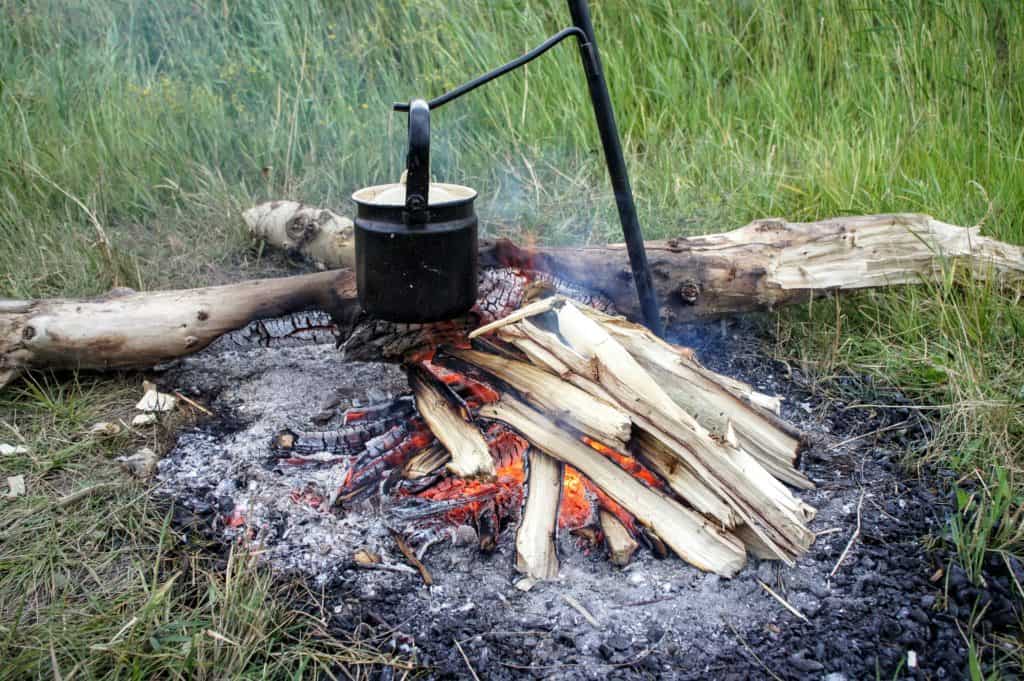
Boiling will kill off almost all microbes, and is a great way to help really limit issues. If you don’t have a metal container handy, heat up rocks and drop them into whatever container you do have.
Make sure it’s really a good rolling boil, and you should be all set. Bear in mind that boiling won’t do anything at all to other contaminants like chemicals, heavy metals, and radionuclides.
Disinfection
If you have them along, iodine or chlorine chemical water treatments are another great insurance policy. They’ll take out almost any microbe, and I’ve heard that the chlorine-based options don’t have nearly so bad a taste as iodine. Just follow the instructions on the bottle and you should be all set.
Another disinfection option is UV light from the sun. If you can scrounge up a soda bottle, simply fill it up with clear water and leave it in bright, direct sunlight for six to eight hours. Murky water will block the UV rays, so don’t count on it unless your water is already clean.
Distillation
If you have chemical problems with your water, then distillation is the way to go. Also the only way to deal with salt water in the field.
Two options exist: ordinary distillation, and solar stills. In ordinary distillation, you boil water to steam, catch the steam, and let it cool back to water. Solar distillation happens at temperatures below boiling.
Distillation requires some equipment and/or ingenuity. Get a fire going, even if you have to resort to primitive fire skills to do it (check out my Primitive Fire Skills article for more info). Boil water by whatever means, either in a fire-resistant container, or by dropping in hot rocks. Then you need to catch the steam with something. A pot lid, pine boughs, or banana leaves can all do the trick. Tilt that something towards another container, and let the condensation drip off.
Solar stills are usually made from trash bags or other plastic wrap. In bright, direct sunlight, place brackish water in a hole or a large pot. Set a catch container inside as well, making sure it won’t fill up with brackish water once full of clean water. Then stretch the plastic over the top, and place a small rock on top to create a low spot over the catch cup. Weight the rest of the plastic down and wait. Water vapor will condense on the plastic and drip down, but it’s a slow process.
In Summary
Microbes are the largest threat, present in almost all surface water sources. They can be dealt with in a variety of ways. There are five other classes of contaminants, none of which will be caught by filters. You can only deal with most of these other classes by adsorption to carbon, or distillation.
I don’t claim any expertise in dealing with radionuclides in water. My advice there is to steer clear, and I’ll relay further research in this area as well.
Generally, try to chain together at least a few of these methods wherever possible. Settle if you can, filter, then boil or disinfect. Distill only as needed, it’s a slow process.
Finally, check out my article on why you need both Filtration and Disinfection in Drinking Water to learn more about various disinfection methods, or Grab my full Book on Water Treatment for Adventurers and Prepped on Amazon!

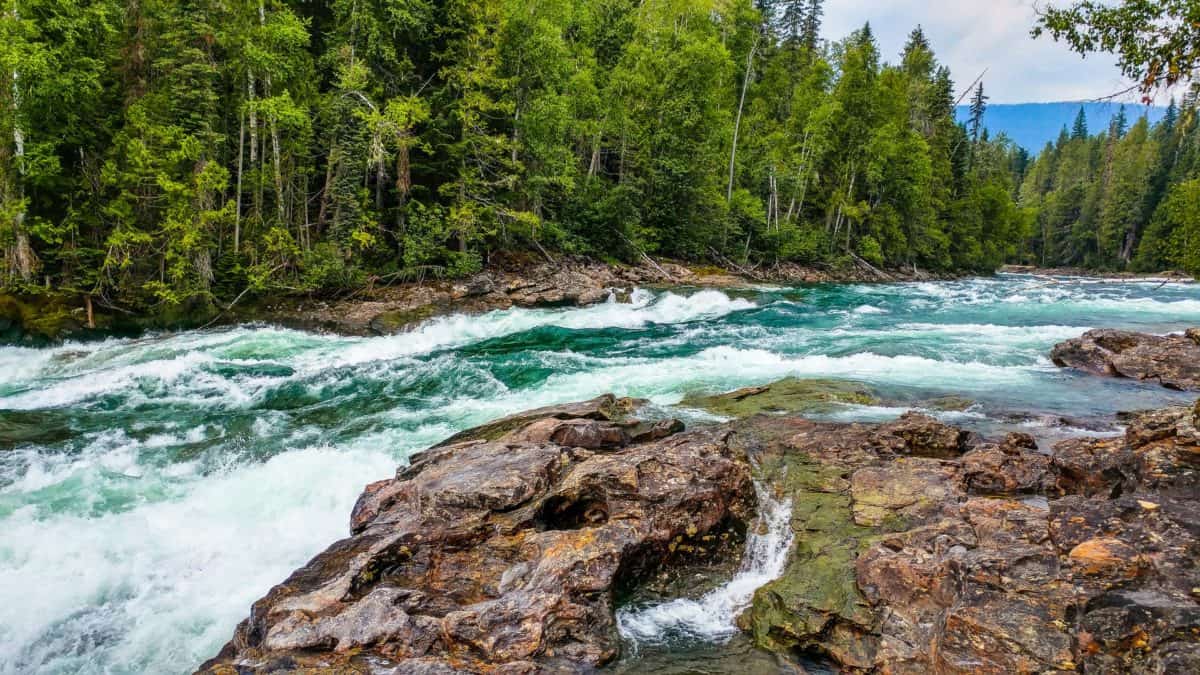
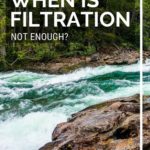
Thi is such a great post with so much information. Very educational! Thank you!